-
 Bitcoin
Bitcoin $99,594.2189
-3.59% -
 Ethereum
Ethereum $2,188.5793
-9.00% -
 Tether USDt
Tether USDt $1.0001
-0.02% -
 XRP
XRP $1.9745
-5.82% -
 BNB
BNB $608.9511
-3.73% -
 Solana
Solana $130.4575
-5.93% -
 USDC
USDC $1.0000
0.01% -
 TRON
TRON $0.2637
-3.59% -
 Dogecoin
Dogecoin $0.1493
-5.97% -
 Cardano
Cardano $0.5322
-6.72% -
 Hyperliquid
Hyperliquid $33.9044
3.33% -
 Bitcoin Cash
Bitcoin Cash $449.6411
-5.46% -
 UNUS SED LEO
UNUS SED LEO $8.9629
0.43% -
 Sui
Sui $2.3943
-8.35% -
 Chainlink
Chainlink $11.4402
-7.83% -
 Stellar
Stellar $0.2241
-6.49% -
 Avalanche
Avalanche $16.1489
-4.24% -
 Toncoin
Toncoin $2.7182
-5.94% -
 Shiba Inu
Shiba Inu $0.0...01040
-5.72% -
 Litecoin
Litecoin $78.7882
-4.07% -
 Ethena USDe
Ethena USDe $1.0004
-0.01% -
 Hedera
Hedera $0.1305
-7.45% -
 Monero
Monero $297.0030
-5.32% -
 Dai
Dai $0.9997
-0.02% -
 Polkadot
Polkadot $3.1834
-6.03% -
 Bitget Token
Bitget Token $3.9788
-7.03% -
 Uniswap
Uniswap $6.1327
-10.62% -
 Pepe
Pepe $0.0...08689
-8.30% -
 Pi
Pi $0.4826
-9.65% -
 Aave
Aave $219.8043
-9.69%
What trend signal does the change in EMA slope represent?
The EMA's slope change signals trend shifts; an upward slope indicates bullish trends, while a downward slope suggests bearish trends, aiding traders' decisions.
May 24, 2025 at 12:29 pm
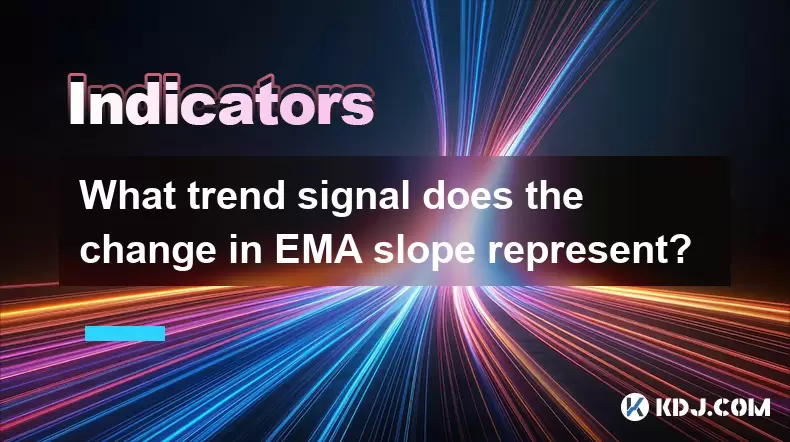
The Exponential Moving Average (EMA) is a popular technical indicator used by traders to analyze trends in the cryptocurrency market. The change in the slope of the EMA can provide significant insights into the market's direction and momentum. This article will explore what trend signal the change in EMA slope represents, how to interpret these changes, and how traders can use this information to make informed decisions.
Understanding the EMA and Its Slope
The Exponential Moving Average (EMA) is a type of moving average that places a greater weight and significance on the most recent data points. Unlike the Simple Moving Average (SMA), which assigns equal weight to all values, the EMA reacts more quickly to recent price changes, making it a valuable tool for traders looking to identify trends in the volatile cryptocurrency market.
The slope of the EMA refers to the direction in which the EMA line is moving. An upward slope indicates that the EMA is increasing, while a downward slope indicates that the EMA is decreasing. The change in the slope of the EMA can signal shifts in market trends and provide traders with potential entry and exit points.
Interpreting an Upward Slope in the EMA
When the EMA line shows an upward slope, it typically indicates a bullish trend in the market. This means that the price of the cryptocurrency is generally increasing over time. An upward slope in the EMA suggests that the recent price movements have been higher than the previous ones, and the market sentiment is positive.
Traders often use an upward sloping EMA as a signal to enter long positions. For instance, if the 50-day EMA is trending upwards and the price of the cryptocurrency is consistently above this line, it may be a good time to buy. The upward slope provides a confirmation that the trend is likely to continue in the same direction, offering potential profit opportunities.
Interpreting a Downward Slope in the EMA
Conversely, a downward slope in the EMA suggests a bearish trend in the market. This indicates that the price of the cryptocurrency is generally decreasing over time. A downward sloping EMA means that recent price movements have been lower than the previous ones, and the market sentiment is negative.
Traders may use a downward sloping EMA as a signal to enter short positions. For example, if the 200-day EMA is trending downwards and the price of the cryptocurrency is consistently below this line, it might be a good opportunity to sell. The downward slope confirms that the bearish trend is likely to persist, allowing traders to capitalize on the downward movement.
Identifying Trend Reversals Using EMA Slope Changes
One of the most critical uses of the EMA slope is to identify potential trend reversals. A change in the slope of the EMA can signal that the current trend may be losing momentum and that a reversal could be imminent.
For instance, if the EMA has been trending upwards but starts to flatten or turn downwards, it could indicate that the bullish trend is weakening. Conversely, if the EMA has been trending downwards but begins to flatten or turn upwards, it might suggest that the bearish trend is losing steam.
Traders can use these slope changes to adjust their positions. If a bullish trend appears to be reversing, traders might consider taking profits or closing long positions. If a bearish trend seems to be reversing, traders might look for opportunities to enter long positions or cover short positions.
Using Multiple EMAs to Confirm Slope Changes
To increase the reliability of the signals provided by the EMA slope, traders often use multiple EMAs with different time periods. For example, a common strategy is to use the 50-day and 200-day EMAs together. The 50-day EMA reacts more quickly to price changes, while the 200-day EMA provides a longer-term perspective.
When both the short-term and long-term EMAs show the same slope direction, it provides a stronger confirmation of the trend. For example, if both the 50-day and 200-day EMAs are trending upwards, it strongly indicates a bullish trend. Conversely, if both EMAs are trending downwards, it strongly suggests a bearish trend.
If the slopes of the short-term and long-term EMAs diverge, it can signal a potential trend change. For instance, if the 50-day EMA starts to trend downwards while the 200-day EMA continues to trend upwards, it might indicate that the short-term trend is reversing, and traders should be cautious.
Practical Example of Using EMA Slope Changes
To illustrate how traders can use the change in EMA slope, let's consider a practical example involving Bitcoin (BTC). Suppose a trader is monitoring the 50-day and 200-day EMAs of Bitcoin.
Initial Scenario: Both the 50-day and 200-day EMAs are trending upwards, indicating a strong bullish trend. The price of Bitcoin is consistently above both EMAs, reinforcing the bullish sentiment.
Change in Slope: After a few weeks, the trader notices that the 50-day EMA starts to flatten and then turns downwards, while the 200-day EMA continues to trend upwards. This divergence suggests that the short-term bullish trend may be weakening, and a potential reversal could be on the horizon.
Trader's Action: The trader decides to take profits on their long positions in Bitcoin and waits for further confirmation of the trend change. If the 50-day EMA continues to trend downwards and crosses below the 200-day EMA (a bearish crossover), the trader might enter short positions or look for other bearish opportunities.
Using EMA Slope Changes in Conjunction with Other Indicators
While the EMA slope can provide valuable insights into market trends, it is often more effective when used in conjunction with other technical indicators. Traders might combine the EMA slope with indicators such as the Relative Strength Index (RSI), Moving Average Convergence Divergence (MACD), or Bollinger Bands to gain a more comprehensive view of the market.
For example, if the EMA slope indicates a bullish trend, but the RSI shows that the cryptocurrency is overbought, traders might exercise caution and wait for a more favorable entry point. Conversely, if the EMA slope indicates a bearish trend, but the MACD shows a bullish divergence, it could suggest that the bearish trend is losing momentum, and a reversal might be imminent.
Frequently Asked Questions
Q1: Can the EMA slope be used as a standalone indicator for trading decisions?
A1: While the EMA slope can provide valuable trend signals, it is generally more effective when used in conjunction with other technical indicators. Relying solely on the EMA slope may lead to false signals and increased risk. Traders should consider using additional indicators to confirm the signals provided by the EMA slope.
Q2: How do different time periods of EMAs affect the interpretation of the slope?
A2: Different time periods of EMAs can provide insights into different aspects of the market. Shorter-term EMAs (e.g., 50-day) are more sensitive to recent price changes and can help identify short-term trends. Longer-term EMAs (e.g., 200-day) provide a broader perspective and can help identify long-term trends. Traders often use multiple EMAs to gain a more comprehensive understanding of the market's direction.
Q3: What are some common mistakes traders make when using the EMA slope?
A3: One common mistake is over-relying on the EMA slope without considering other market factors. Traders might also misinterpret the slope changes, such as mistaking a temporary flattening of the EMA for a trend reversal. It's important to use the EMA slope as part of a broader trading strategy and to consider other technical and fundamental factors before making trading decisions.
Q4: How can traders avoid false signals when using the EMA slope?
A4: To avoid false signals, traders should use the EMA slope in conjunction with other technical indicators and consider the overall market context. It's also helpful to use multiple EMAs with different time periods to confirm the trend signals. Additionally, traders should be patient and wait for clear confirmations of trend changes before making trading decisions.
Disclaimer:info@kdj.com
The information provided is not trading advice. kdj.com does not assume any responsibility for any investments made based on the information provided in this article. Cryptocurrencies are highly volatile and it is highly recommended that you invest with caution after thorough research!
If you believe that the content used on this website infringes your copyright, please contact us immediately (info@kdj.com) and we will delete it promptly.
- Altcoins Under Pressure: Cardano and XRP Face Critical Tests
- 2025-06-23 12:25:12
- Rare Coin Fever in Wiltshire: Auctions, Errors, and Olympic Gold!
- 2025-06-23 12:25:12
- XRP Price Under Pressure: War Fears and Market Sentiment
- 2025-06-23 12:30:12
- HAI Token Private Key Leak: What Happened and How to Stay Safe
- 2025-06-23 12:45:12
- Texas Goes All In: Bitcoin Reserve Signals Big State Embrace
- 2025-06-23 12:45:12
- Pi Network's Price Plunge: Crash, Scammer Accusations, and What's Next?
- 2025-06-23 13:05:12
Related knowledge
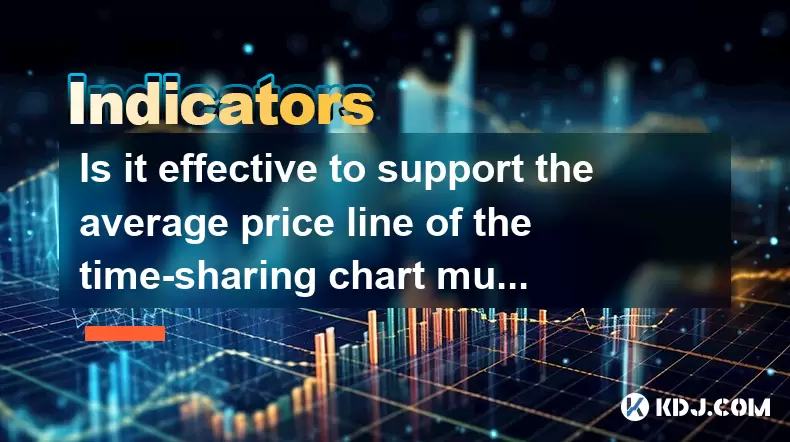
Is it effective to support the average price line of the time-sharing chart multiple times?
Jun 23,2025 at 01:36pm
Understanding the Average Price Line in Time-Sharing ChartsIn cryptocurrency trading, time-sharing charts refer to real-time price charts that display price movements over short intervals, often within a single trading day. Within these charts, the average price line, also known as the Volume Weighted Average Price (VWAP), is a commonly used technical i...
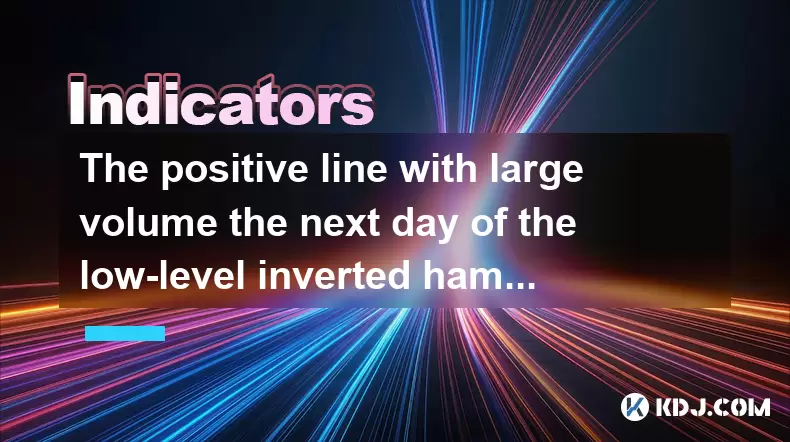
The positive line with large volume the next day of the low-level inverted hammer line confirms the reversal?
Jun 23,2025 at 01:21pm
Understanding the Low-Level Inverted Hammer LineThe inverted hammer line is a single candlestick pattern that typically appears at the end of a downtrend. It has a small real body near the bottom of the trading range and a long upper shadow, indicating that bulls attempted to push prices higher but were met with selling pressure. When this pattern forms...
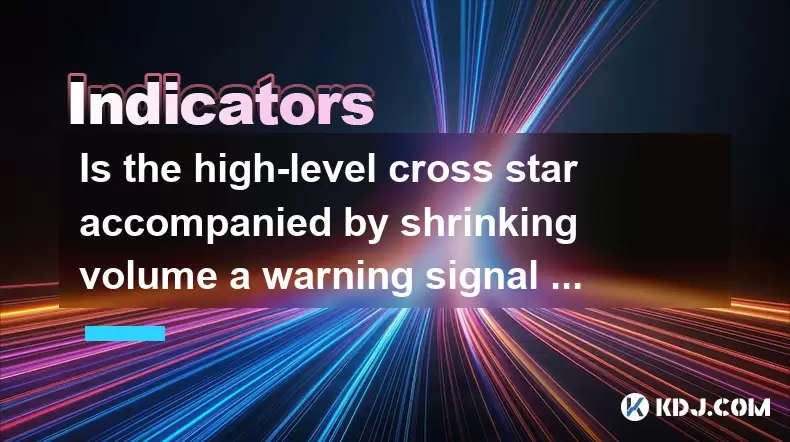
Is the high-level cross star accompanied by shrinking volume a warning signal of peaking?
Jun 23,2025 at 01:28pm
Understanding High-Level Cross Star PatternsIn the world of cryptocurrency trading, candlestick patterns are essential tools for technical analysis. One such pattern is the high-level cross star, which appears as a doji or near-doji candle at a significant resistance level. This pattern often indicates indecision in the market and can be interpreted as ...
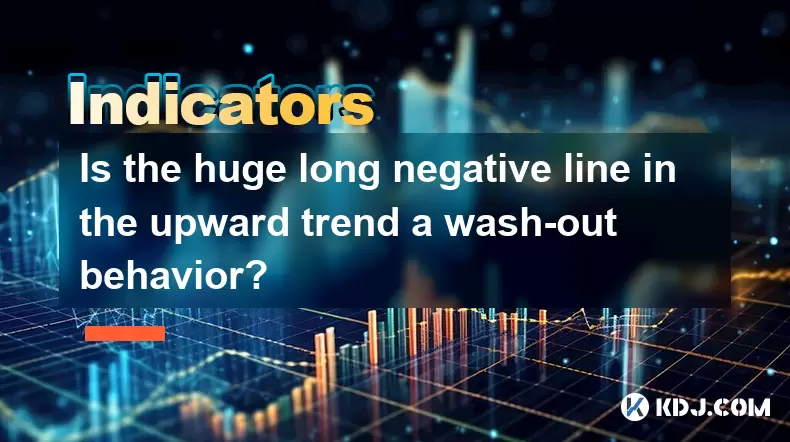
Is the huge long negative line in the upward trend a wash-out behavior?
Jun 23,2025 at 12:49pm
Understanding the Long Negative Candlestick in an Uprising TrendA long negative candlestick, often referred to as a long red or bearish candle, appearing during an upward trend can raise concerns among traders and investors. This pattern typically indicates a sudden and significant drop in price after a period of rising prices. It is often interpreted a...

Can the EXPMA golden cross stand on the 5-day line at the same time?
Jun 23,2025 at 11:42am
Understanding the EXPMA Indicator in Cryptocurrency TradingThe Exponential Moving Average (EXPMA) is a popular technical analysis tool used by cryptocurrency traders to identify trends and potential reversal points. Unlike simple moving averages, the EXPMA gives more weight to recent price data, making it more responsive to current market conditions. In...

Does the second surge in the RSI overbought zone induce more?
Jun 22,2025 at 08:35am
Understanding the RSI Overbought ZoneThe Relative Strength Index (RSI) is a momentum oscillator commonly used in technical analysis to measure the speed and change of price movements. It ranges from 0 to 100, with values above 70 typically considered overbought and values below 30 considered oversold. When the RSI enters the overbought zone for the firs...

Is it effective to support the average price line of the time-sharing chart multiple times?
Jun 23,2025 at 01:36pm
Understanding the Average Price Line in Time-Sharing ChartsIn cryptocurrency trading, time-sharing charts refer to real-time price charts that display price movements over short intervals, often within a single trading day. Within these charts, the average price line, also known as the Volume Weighted Average Price (VWAP), is a commonly used technical i...

The positive line with large volume the next day of the low-level inverted hammer line confirms the reversal?
Jun 23,2025 at 01:21pm
Understanding the Low-Level Inverted Hammer LineThe inverted hammer line is a single candlestick pattern that typically appears at the end of a downtrend. It has a small real body near the bottom of the trading range and a long upper shadow, indicating that bulls attempted to push prices higher but were met with selling pressure. When this pattern forms...

Is the high-level cross star accompanied by shrinking volume a warning signal of peaking?
Jun 23,2025 at 01:28pm
Understanding High-Level Cross Star PatternsIn the world of cryptocurrency trading, candlestick patterns are essential tools for technical analysis. One such pattern is the high-level cross star, which appears as a doji or near-doji candle at a significant resistance level. This pattern often indicates indecision in the market and can be interpreted as ...

Is the huge long negative line in the upward trend a wash-out behavior?
Jun 23,2025 at 12:49pm
Understanding the Long Negative Candlestick in an Uprising TrendA long negative candlestick, often referred to as a long red or bearish candle, appearing during an upward trend can raise concerns among traders and investors. This pattern typically indicates a sudden and significant drop in price after a period of rising prices. It is often interpreted a...

Can the EXPMA golden cross stand on the 5-day line at the same time?
Jun 23,2025 at 11:42am
Understanding the EXPMA Indicator in Cryptocurrency TradingThe Exponential Moving Average (EXPMA) is a popular technical analysis tool used by cryptocurrency traders to identify trends and potential reversal points. Unlike simple moving averages, the EXPMA gives more weight to recent price data, making it more responsive to current market conditions. In...

Does the second surge in the RSI overbought zone induce more?
Jun 22,2025 at 08:35am
Understanding the RSI Overbought ZoneThe Relative Strength Index (RSI) is a momentum oscillator commonly used in technical analysis to measure the speed and change of price movements. It ranges from 0 to 100, with values above 70 typically considered overbought and values below 30 considered oversold. When the RSI enters the overbought zone for the firs...
See all articles

























































































